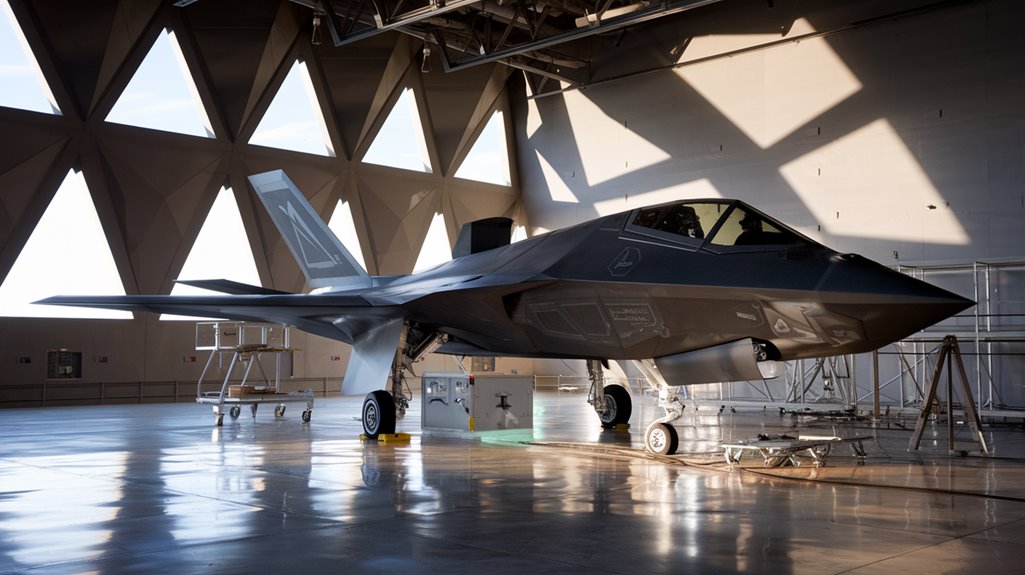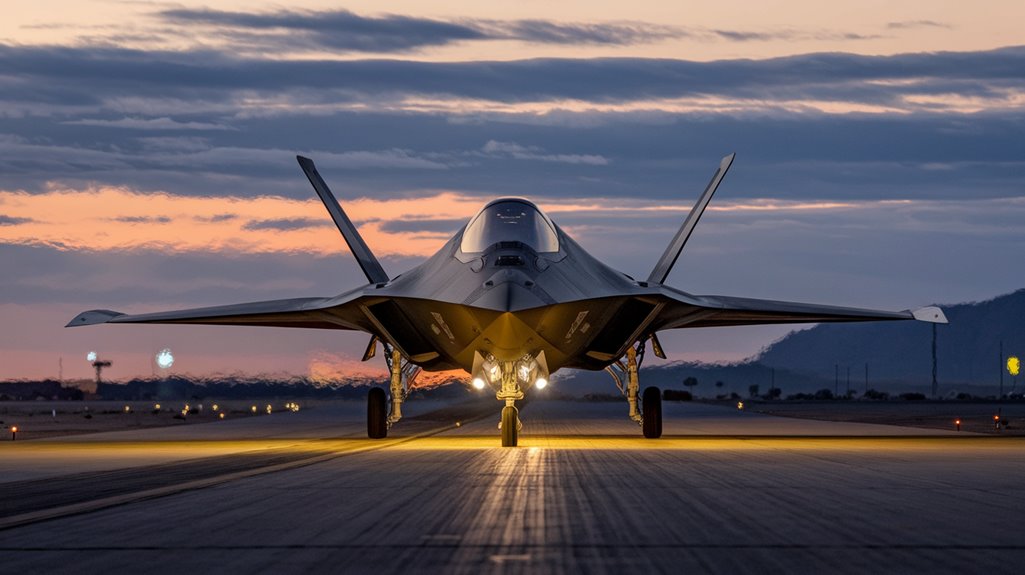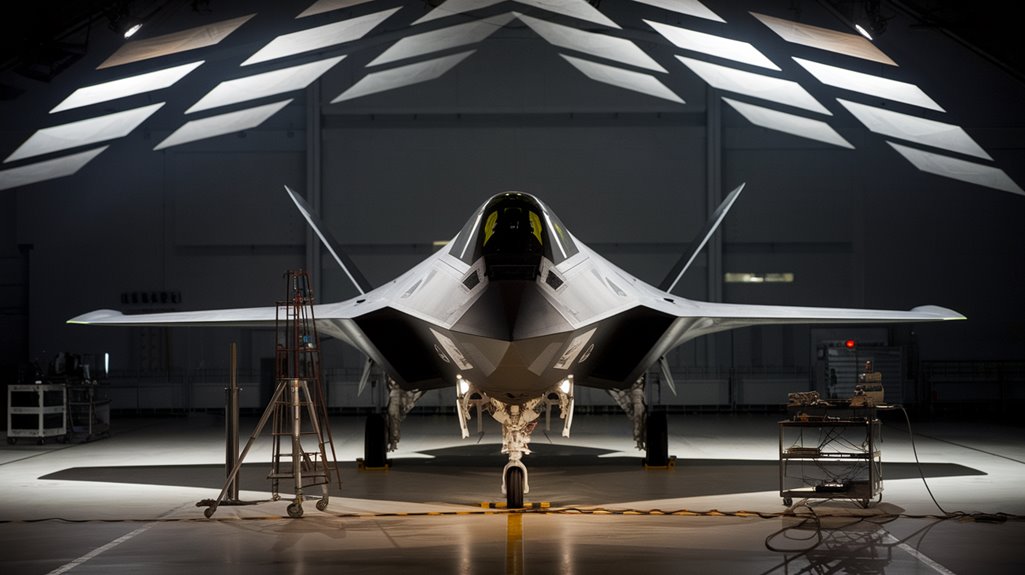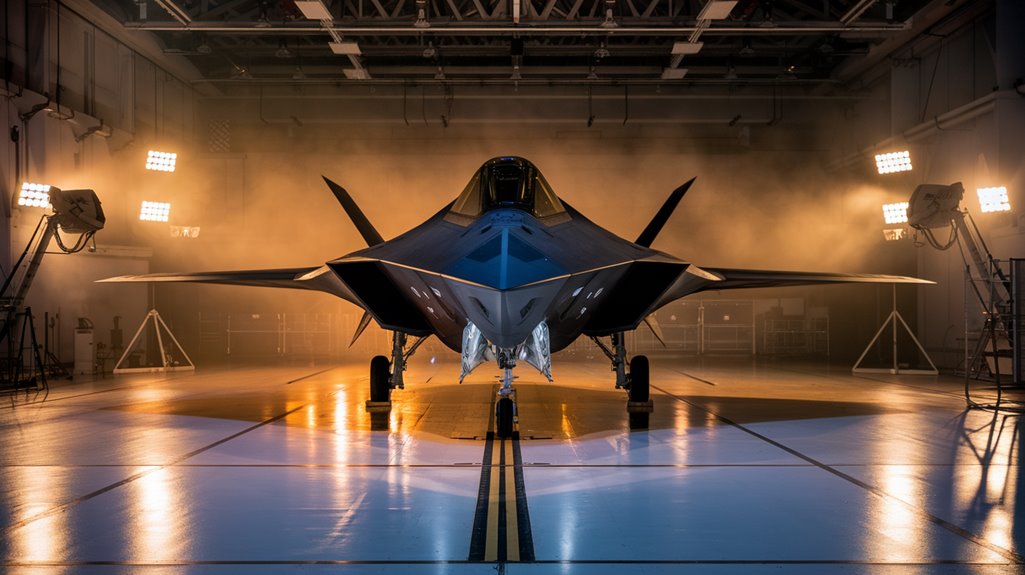Stealth Tech Revealed: How Planes Vanish on Radar
You've probably wondered how military aircraft can seemingly disappear from radar screens. It's not magic – it's the result of decades of engineering innovation and scientific breakthroughs. From specially angled surfaces that scatter radar waves to advanced materials that absorb electromagnetic energy, stealth technology has transformed modern aerial warfare. As you'll discover, these invisible warriors of the sky represent one of aviation's most closely guarded secrets, and their capabilities continue to evolve in remarkable ways.
The Science Behind Radar Invisibility

While traditional aircraft rely primarily on speed and maneuverability to evade detection, modern stealth technology uses sophisticated physics and engineering to achieve radar invisibility.
You'll find that stealth aircraft employ multiple strategies to minimize their radar signature. One cutting-edge method involves plasma dynamics, where an ionized layer surrounds the aircraft, absorbing and dispersing incoming radar waves rather than reflecting them back. The resulting plasma cloud absorption creates a significant decrease in radar reflectivity, making the aircraft harder to detect. The development of these technologies began when mathematical modeling emerged from Petr Ufimtsev's breakthrough work in the 1970s.
The technology's effectiveness lies in its ability to handle various radar frequencies through a combination of specialized materials and design features.
When radar waves hit a stealth aircraft, they encounter surfaces engineered to either absorb the signals or redirect them away from the source. This all-encompassing approach includes radar-absorbent materials, carefully angled surfaces, and internal compartments that reduce exposed areas, making the aircraft nearly invisible to conventional detection systems.
Shaping Aircraft to Deceive Radar
Aircraft designers employ precise geometric principles to outsmart radar detection systems. The key shaping techniques involve using flat, angled surfaces instead of curves, ensuring radar waves bounce away from their source.
You'll notice stealth geometry relies heavily on aligned edges and flattened fuselages, deliberately avoiding right angles that could create unwanted reflections. These features, combined with deception jamming techniques, help create confusion in enemy radar systems. Modern stealth aircraft often incorporate corner reflectors to strategically redirect radar signals.
Re-entrant triangles built into the airframe help dissipate radar energy, while serpentine intakes scatter incoming waves through carefully designed curved paths.
The aircraft's leading edges are crafted like toothpicks – sharp and thin – to minimize radar returns. These design elements work together with surface orientations that don't point toward likely threat directions.
When combined with radar-absorbent materials, these shaping methods create an aircraft that's incredibly difficult for radar systems to detect.
Advanced Materials That Swallow Radio Waves
Modern stealth technology relies heavily on radio-absorbing materials (RAM) that effectively swallow radar waves before they can bounce back to detection systems.
These advanced RAM applications use innovative fillers like carbon black, graphite, and carbon fibers to trap electromagnetic waves across different frequencies. To maximize performance, these materials incorporate equal dielectric permeability to minimize radar wave reflections. Recent testing has shown stable absorption performance even at extreme 60-degree angles.
You'll find these materials applied in multiple layers on stealth aircraft, where they work alongside special coatings made through ion-plasma magnetron sputtering.
The latest developments include thin films containing ferromagnetic nanoparticles that can achieve impressive absorption rates across frequencies from 7 to 70 GHz.
Even more remarkable are the new bionic gyroid structures and bio-inspired metastructures that can absorb waves across an ultra-wide bandwidth of 2-40 GHz, making aircraft nearly invisible to conventional radar systems.
Heat Management: Beyond Radar Detection
Beyond the challenge of radar evasion, effective stealth technology must tackle the vital issue of heat signatures. Modern stealth aircraft employ a sophisticated array of thermal coatings and insulation materials to minimize their infrared footprint.
You'll find these planes equipped with specialized cooling systems and heat sinks that efficiently dissipate excess thermal energy. The integration of non-metallic composite materials helps reduce both radar signature and heat retention.
Exhaust management plays a significant role in heat reduction. Through advanced nozzle designs and thrust vectoring, hot engine gases mix with cooler air before leaving the aircraft. Engine mounting above wings helps minimize heat detection from ground-based sensors.
Ceramic coatings on engine components further reduce thermal radiation, while carefully placed cooling channels help maintain lower temperatures throughout the system.
During missions, pilots utilize strategic operational methods, flying at specific altitudes and reducing engine power when necessary to keep their heat signatures as low as possible.
Modern Stealth Aircraft in Action

The application of stealth technology shines brightest in today's most advanced military aircraft. You'll find cutting-edge examples like the F-22 Raptor and B-21 Raider employing sophisticated design elements that make them nearly invisible to conventional radar systems.
In combat scenarios, these aircraft leverage multiple stealth features: carefully positioned engines, radar-absorbing materials, and angular surfaces that deflect radar waves away from enemy receivers. Their operational tactics often involve carefully planned mission routes to maintain minimal radar cross-sections. The B2 flying wing design exemplifies how modern stealth aircraft maximize their ability to avoid detection while maintaining superior combat capabilities. When aircraft release weapons, their radar visibility increases significantly due to opened weapons bays.
You'll see this technology at work in international platforms too, like China's J-20 and Russia's Su-57.
While the F-117 Nighthawk pioneered stealth design, modern aircraft have evolved remarkably, integrating AI-driven systems and adaptive camouflage to enhance their survival capabilities in increasingly complex battlefield environments.
The Future of Stealth Technology
As military technology races forward, stealth innovations are poised to transform warfare through revolutionary advancements in AI, materials science, and unmanned systems.
You'll see AI integration transforming stealth capabilities with real-time threat responses and adaptive flight paths that minimize detection risks. Flat surfaces and edges have become essential design elements in modern stealth aircraft, replacing traditional rounded shapes.
Advanced materials and designs are reshaping how aircraft and ships avoid radar detection, while plasma innovations offer groundbreaking solutions. The B-21 Raider represents the latest evolution in stealth technology with unprecedented survivability features.
You can expect to see closed electron beam plasma fields making aircraft virtually invisible to radar, particularly around critical areas like cockpits and radar domes.
The future also brings unmanned platforms equipped with cutting-edge stealth features.











